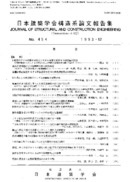398 巻
選択された号の論文の22件中1~22を表示しています
- |<
- <
- 1
- >
- >|
-
原稿種別: 表紙
1989 年 398 巻 p. Cover1-
発行日: 1989/04/30
公開日: 2017/12/25
PDF形式でダウンロード (72K) -
原稿種別: 表紙
1989 年 398 巻 p. Cover2-
発行日: 1989/04/30
公開日: 2017/12/25
PDF形式でダウンロード (72K) -
原稿種別: 付録等
1989 年 398 巻 p. App1-
発行日: 1989/04/30
公開日: 2017/12/25
PDF形式でダウンロード (131K) -
原稿種別: 目次
1989 年 398 巻 p. Toc1-
発行日: 1989/04/30
公開日: 2017/12/25
PDF形式でダウンロード (124K) -
原稿種別: 目次
1989 年 398 巻 p. Toc2-
発行日: 1989/04/30
公開日: 2017/12/25
PDF形式でダウンロード (56K) -
原稿種別: 目次
1989 年 398 巻 p. Toc3-
発行日: 1989/04/30
公開日: 2017/12/25
PDF形式でダウンロード (56K) -
原稿種別: 本文
1989 年 398 巻 p. 1-11
発行日: 1989/04/30
公開日: 2017/12/25
PDF形式でダウンロード (1053K) -
原稿種別: 本文
1989 年 398 巻 p. 13-22
発行日: 1989/04/30
公開日: 2017/12/25
PDF形式でダウンロード (1360K) -
原稿種別: 本文
1989 年 398 巻 p. 23-30
発行日: 1989/04/30
公開日: 2017/12/25
PDF形式でダウンロード (888K) -
原稿種別: 本文
1989 年 398 巻 p. 31-41
発行日: 1989/04/30
公開日: 2017/12/25
PDF形式でダウンロード (1101K) -
原稿種別: 本文
1989 年 398 巻 p. 43-51
発行日: 1989/04/30
公開日: 2017/12/25
PDF形式でダウンロード (1003K) -
原稿種別: 本文
1989 年 398 巻 p. 53-60
発行日: 1989/04/30
公開日: 2017/12/25
PDF形式でダウンロード (872K) -
原稿種別: 本文
1989 年 398 巻 p. 61-71
発行日: 1989/04/30
公開日: 2017/12/25
PDF形式でダウンロード (1078K) -
原稿種別: 本文
1989 年 398 巻 p. 73-86
発行日: 1989/04/30
公開日: 2017/12/25
PDF形式でダウンロード (1280K) -
原稿種別: 本文
1989 年 398 巻 p. 87-98
発行日: 1989/04/30
公開日: 2017/12/25
PDF形式でダウンロード (1712K) -
原稿種別: 本文
1989 年 398 巻 p. 99-108
発行日: 1989/04/30
公開日: 2017/12/25
PDF形式でダウンロード (928K) -
原稿種別: 本文
1989 年 398 巻 p. 109-119
発行日: 1989/04/30
公開日: 2017/12/25
PDF形式でダウンロード (1109K) -
原稿種別: 本文
1989 年 398 巻 p. 121-129
発行日: 1989/04/30
公開日: 2017/12/25
PDF形式でダウンロード (929K) -
原稿種別: 本文
1989 年 398 巻 p. 131-141
発行日: 1989/04/30
公開日: 2017/12/25
PDF形式でダウンロード (1867K) -
原稿種別: 本文
1989 年 398 巻 p. 143-153
発行日: 1989/04/30
公開日: 2017/12/25
PDF形式でダウンロード (1022K) -
原稿種別: 付録等
1989 年 398 巻 p. App2-
発行日: 1989/04/30
公開日: 2017/12/25
PDF形式でダウンロード (47K) -
原稿種別: 表紙
1989 年 398 巻 p. Cover3-
発行日: 1989/04/30
公開日: 2017/12/25
PDF形式でダウンロード (65K)
- |<
- <
- 1
- >
- >|
